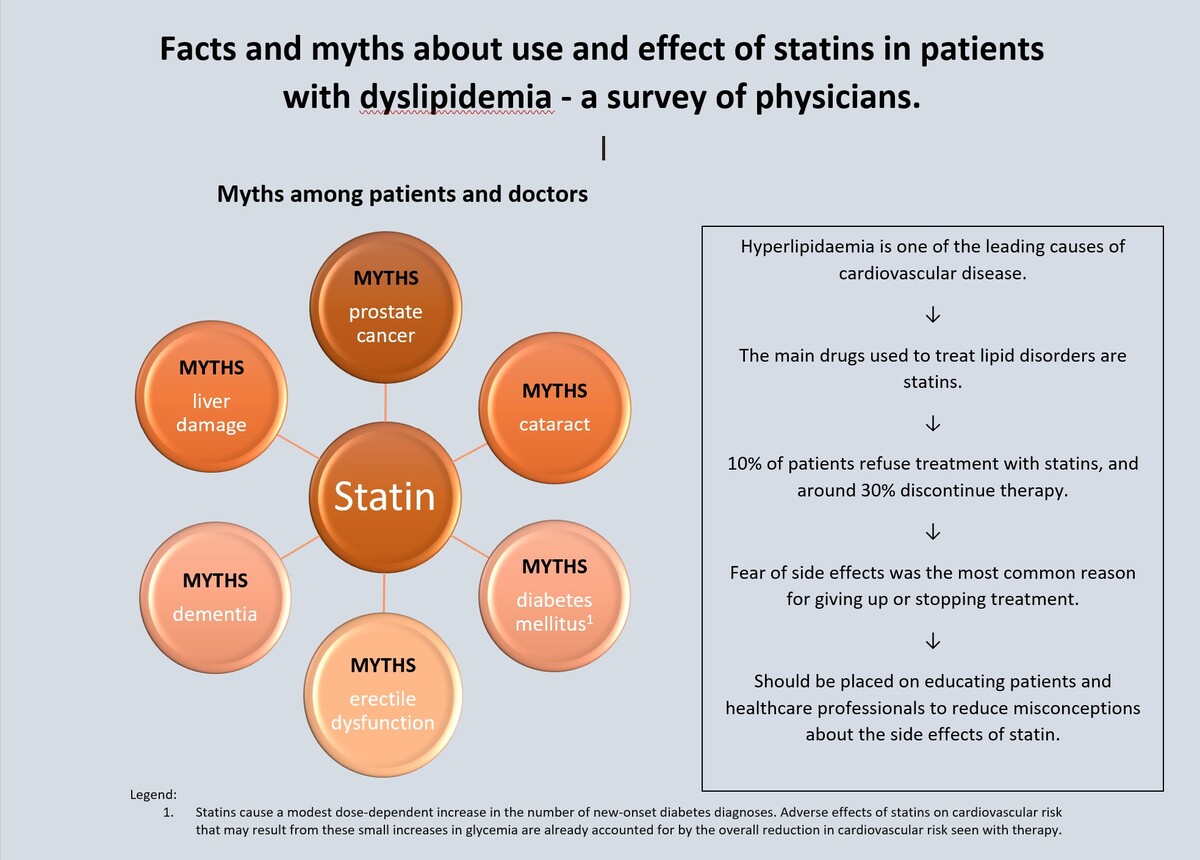Current issue
Archive
Manuscripts accepted
About the Journal
Editorial office
Editorial board
Section Editors
Abstracting and indexing
Subscription
Contact
Ethical standards and procedures
Most read articles
Instructions for authors
Article Processing Charge (APC)
Regulations of paying article processing charge (APC)
LIPID DISORDERS / RESEARCH PAPER
Facts and myths about use and effect of statins in patients with dyslipidaemia - a survey of physicians.
1
AD-Med Medical Center, 1 Syrokomli St., 51-141 Wrocław, Poland
2
Department of Family Medicine, Wroclaw Medical University, 50-367 Wroclaw, Poland, Poland
3
MEDFIT Karolina Kloda, 13 E/11 Narutowicza St., 70-240 Szczecin, Poland, Poland
Submission date: 2024-05-30
Final revision date: 2024-11-03
Acceptance date: 2024-12-03
Online publication date: 2025-02-22
Corresponding author
Mateusz Babicki
Department of Family Medicine, Wroclaw Medical University, 50-367 Wroclaw, Poland, Syrokomli 1, 51-141, Wrocław, Poland
Department of Family Medicine, Wroclaw Medical University, 50-367 Wroclaw, Poland, Syrokomli 1, 51-141, Wrocław, Poland
KEYWORDS
TOPICS
ABSTRACT
Introduction:
Statins are the primary medications used to treat lipid disorders. However, numerous myths surrounding statin therapy lead to patient non-adherence and therapy discontinuation. The aim of this study was to assess the most common patient concerns regarding statin use.
Material and methods:
A survey was conducted targeting doctors using an online questionnaire The first section included questions regarding socio-economic status, while the second focused on patient experiences related to refusing statin treatment due to fears of specific side effects, encounters with side effects during therapy, and estimates of the percentage of patients who discontinue treatment. The concluding section addressed the most common reasons for treatment termination from the perspective of practitioners, along with efforts to educate their patients.
Results:
260 questionnaires were collected. Notably, 84% and 81% of doctors reported encountering refusals of statin treatment due to patients’ fears of liver and muscle damage, respectively. The majority of respondents indicated that 10-20% of patients discontinue treatment on their own, despite significant side effects occurring in less than 10% of cases. Muscular symptoms were cited as the reason for discontinuing therapy in 75% of cases, while misinformation regarding statin side effects contributed to 53% of discontinuations. Additionally, 96.5% of doctors acknowledged efforts to educate their patients about statins.
Conclusions:
Many harmful beliefs about the side effects of statins persist among patients, resulting in non-adherence to treatment. The most prevalent concerns involve fears related to muscle and liver damage. These issues can be mitigated through targeted education for both patients and healthcare professionals.
Statins are the primary medications used to treat lipid disorders. However, numerous myths surrounding statin therapy lead to patient non-adherence and therapy discontinuation. The aim of this study was to assess the most common patient concerns regarding statin use.
Material and methods:
A survey was conducted targeting doctors using an online questionnaire The first section included questions regarding socio-economic status, while the second focused on patient experiences related to refusing statin treatment due to fears of specific side effects, encounters with side effects during therapy, and estimates of the percentage of patients who discontinue treatment. The concluding section addressed the most common reasons for treatment termination from the perspective of practitioners, along with efforts to educate their patients.
Results:
260 questionnaires were collected. Notably, 84% and 81% of doctors reported encountering refusals of statin treatment due to patients’ fears of liver and muscle damage, respectively. The majority of respondents indicated that 10-20% of patients discontinue treatment on their own, despite significant side effects occurring in less than 10% of cases. Muscular symptoms were cited as the reason for discontinuing therapy in 75% of cases, while misinformation regarding statin side effects contributed to 53% of discontinuations. Additionally, 96.5% of doctors acknowledged efforts to educate their patients about statins.
Conclusions:
Many harmful beliefs about the side effects of statins persist among patients, resulting in non-adherence to treatment. The most prevalent concerns involve fears related to muscle and liver damage. These issues can be mitigated through targeted education for both patients and healthcare professionals.
Share
RELATED ARTICLE
We process personal data collected when visiting the website. The function of obtaining information about users and their behavior is carried out by voluntarily entered information in forms and saving cookies in end devices. Data, including cookies, are used to provide services, improve the user experience and to analyze the traffic in accordance with the Privacy policy. Data are also collected and processed by Google Analytics tool (more).
You can change cookies settings in your browser. Restricted use of cookies in the browser configuration may affect some functionalities of the website.
You can change cookies settings in your browser. Restricted use of cookies in the browser configuration may affect some functionalities of the website.



